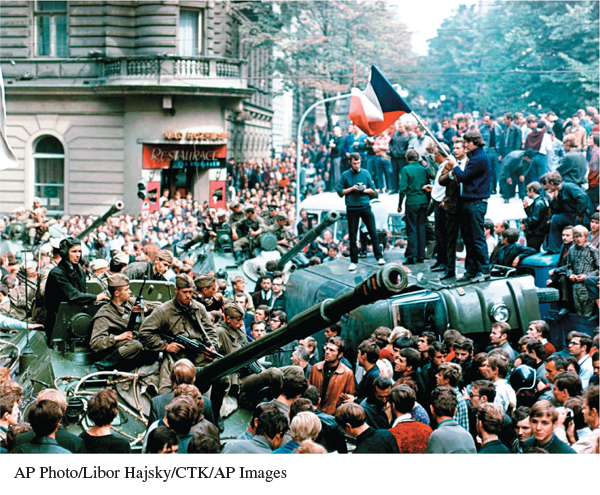A History of Western Society: Printed Page 990
A History of Western Society, Value Edition: Printed Page 951
A History of Western Society, Concise Edition: Printed Page 993
Chapter Chronology
The 1960s in the East Bloc
The building of the Berlin Wall in 1961 suggested that communism was there to stay, and NATO’s refusal to intervene showed that the United States and western Europe basically accepted the premise. In the West, the wall became a potent symbol of the repressive nature of communism in the East Bloc, where halting experiments with economic and cultural liberalization brought only limited reform.
East Bloc economies clearly lagged behind those of the West, exposing the weaknesses of central planning. To address these problems, in the 1960s Communist governments implemented cautious forms of decentralization and limited market policies. The results were mixed. Hungary’s so-called New Economic Mechanism, which broke up state monopolies, allowed some private retail stores, and encouraged private agriculture, was perhaps most successful. East Germany’s New Economic System, inaugurated in 1963, also brought moderate success, though it was reversed when the government returned to centralization in the late 1960s. In other East Bloc countries, however, economic growth flagged.
Recognizing that the overwhelming emphasis on heavy industry was generating popular discontent, Communist planning commissions began to redirect resources to the consumer sector. Again, the results varied. By 1970, for example, ownership of televisions in the more developed nations of East Germany, Czechoslovakia, and Hungary approached that of the affluent nations of western Europe, and other consumer goods were also more available. In Poland, by contrast, the economy stagnated in the 1960s. In the more conservative Albania and Romania, where leaders held fast to Stalinist practices, provision of consumer goods faltered. In general, ordinary people in the East Bloc grew increasingly tired of the shortages of basic consumer goods that seemed an endemic problem in Communist society.

The East German Trabi This small East German passenger car, pictured here in a 1980s advertisement, was one of the best-known symbols of everyday life in East Germany. Produced between 1963 and 1990, the cars were notorious for their poor engineering. The growing number of Trabis on East German streets nonetheless testified to the increased availability of consumer goods in the East Bloc in the 1960s and 1970s.
(akg-images)
Page 991
In the 1960s Communist regimes cautiously granted cultural freedoms. In the Soviet Union, the cultural thaw allowed dissidents like Aleksandr Solzhenitsyn to publish critical works of fiction (see Chapter 28), and this relative tolerance spread to other East Bloc countries as well. In East Germany, for example, during the Bitterfeld Movement — named after a conference of writers, officials, and workers held at Bitterfeld, an industrial city south of Berlin — the regime encouraged intellectuals to take a more critical view of life in the East Bloc, as long as they did not directly oppose communism. Author Christa Wolf’s novel Divided Heaven (1963) is a classic example of the genre. Though the protagonist’s boyfriend emigrates to West Germany in search of better work conditions and she sees very real problems in her small-town factory, she remains committed to building socialism.
Cultural openness only went so far, however. The most outspoken dissidents were harassed and often forced to emigrate to the West; other critics contributed to the rise of an underground samizdat (SAH-meez-daht) literature that emerged in the Soviet Union and the East Bloc. The label samizdat, a Russian term meaning “self-published,” referred to books, periodicals, newspapers, and pamphlets published secretly and passed hand to hand by dissident readers because the works directly criticized communism and thus went far beyond the limits of criticism accepted by the state. Samizdat literature emerged in Russia, Poland, and other countries in the mid-1950s and blossomed in the 1960s. These unofficial networks of communication kept critical thought alive and built contacts among dissidents, creating the foundation for the reform movements of the 1970s and 1980s.
The citizens of East Bloc countries sought political liberty as well, and the limits on reform were sharply revealed in Czechoslovakia during the 1968 “Prague Spring” (named for the country’s capital city). In January 1968 reform elements in the Czechoslovak Communist Party gained a majority and voted out the long-time Stalinist leader in favor of Alexander Dubček (1921–1992), whose new regime launched dramatic reforms. Educated in Moscow, Dubček (DOOB-chehk) was a dedicated Communist, but he and his allies believed that they could reconcile genuine socialism with personal freedom and party democracy. They called for relaxed state censorship and replaced rigid bureaucratic planning with local decision making by trade unions, workers’ councils, and consumers. The reform program — labeled “Socialism with a Human Face” — proved enormously popular.
Remembering that the Hungarian revolution had revealed the difficulty of reforming communism from within (see Chapter 28), Dubček constantly proclaimed his loyalty to the Soviet Union and the Warsaw Pact. But the determination of the Czechoslovak reformers to build a more liberal and democratic socialism nevertheless threatened hard-line Communists, particularly in Poland and East Germany, where leaders knew full well that they lacked popular support. Moreover, Soviet leaders feared that a liberalized Czechoslovakia would eventually be drawn to neutrality or even to NATO. Thus the East Bloc leadership launched a concerted campaign of intimidation against the reformers. Finally, in August 1968, five hundred thousand Soviet and East Bloc troops occupied Czechoslovakia. The Czechoslovaks made no attempt to resist militarily, and the arrested leaders surrendered to Soviet demands. The reform program was abandoned, and the Czechoslovak experiment in humanizing communism from within came to an end.

The Invasion of Czechoslovakia Armed with Czechoslovakian flags, courageous Czechs in downtown Prague try to stop a Soviet tank and repel the invasion and occupation of their country by the Soviet Union and its eastern European allies. Realizing that military resistance would be suicidal, the Czechs capitulated to Soviet control.
(AP Photo/Libor Hajsky/CTK/AP Images)
Page 992
Shortly after the invasion of Czechoslovakia, Soviet premier Leonid Brezhnev (1906–1982) announced that the Soviets would now follow the so-called Brezhnev Doctrine, under which the Soviet Union and its allies had the right to intervene militarily in any East Bloc country whenever they thought doing so was necessary to preserve Communist rule. The 1968 invasion of Czechoslovakia was the crucial event of the Brezhnev era: it demonstrated the determination of the Communist elite to maintain the status quo throughout the Soviet bloc, which would last for another twenty years. At the same time, the Soviet crackdown encouraged dissidents to change their focus from “reforming” Communist regimes from within to building a civil society that might bring internal freedoms independent of the regimes (see “Dissent in Czechoslovakia and Poland”).

